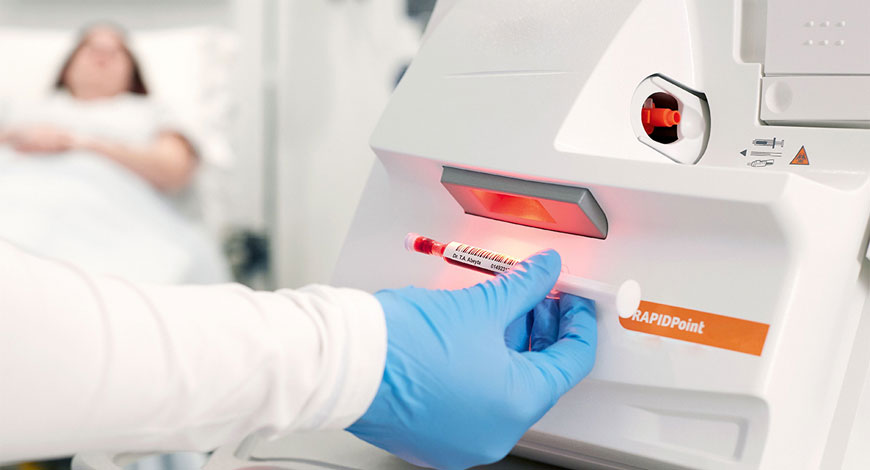Blood Banks
Portable devices gaining prominence

The increasing point-of-care testing in acute care venues is boosting demand for blood gas and electrolyte analyzers.
The increase in COVID-19 hospitalizations is more than counterbalancing the decline in non-COVID-19 ICU admissions due to surgery cancellations and postponement. Hospitalization rates remain high in the age group of 60 to 79 years. The overwhelming caseload of COVID-19 patients globally has burdened the healthcare system and created a pressing demand for diagnostic solutions and medical interventions.
For COVID-19 patients that display signs of respiratory distress, or who are admitted in ICU units and are on ventilation support, blood gas testing is considered crucial. The assessment of damage caused due to COVID-19 in patients requires several diagnostic tests and medical interventions. While reverse transcription-polymerase chain reaction (RT-PCR) tests remain gold standard to diagnose the infection, critical care tests including blood gas and electrolyte analyzers are gaining attention among the medical fraternity for effective treatment decisions. Arterial blood gas analyzers offer measurement related to acid-base status and blood oxygenation along with gas exchange efficiency of the lungs. The device gains relevance in helping medical professionals effectively manage COVID-19 patients while making relevant treatment decisions.
Blood electrolyte analysis market
 Kapil Jadhav
Kapil Jadhav
Corporate Service Manager,
Beacon Group
Electrolytes are positively or negatively charged molecules, which are found in body’s cells and extracellular fluids. There are seven such major electrolytes, which play key role in maintenance of body functions. Imbalance of these essential molecules is associated with many chronic and acute diseases, and hence monitoring their levels becomes one of the most important aspects in clinical diagnosis.
Considering the significant importance of electrolyte measurement, they are widely used in clinical settings like stand-alone laboratories, hospitals, and critical-care situations. The global market for these range of products is projected to reach USD 1588.2 million in 2026 from USD 1145.3 million in 2021 with a CAGR of 5.6 percent over a period of 2021 to 2026.
From the age-old technologies like flame photometry to the most advanced technologies used today like multi-biosensor modules with microfluidic are creating strong pavements for the tremendous growth potential of this market.
The rise in ageing populations requiring treatments in ICU, emergency, as well as operative care induces market opportunity for electrolyte analysis. Use of respiratory therapy and POC applications is also enhancing the shift in demand for these tests. Technology continues to remain milestone for the success of this market. Technology sparkle in this market demonstrates itself in the form of minimizing device size with sophistications, which lead to the development of sleek, compact, and handheld analyzers. Reducing to micro-level sampling and cost per test are also major factors that drive the technology growth in this market.
Integrating larger test menu to offer multiple electrolytes testing together with blood urea nitrogen and creatinine from a single sample also enhances the demand for electrolyte analyzer.
With constant rising of healthcare cost, the challenges are to reduce cost per test and labor costs. Analyzers with larger integrated test menu, using microvolume samples by adopting technologies like microfluidics, are the cornerstones in this market segment.
As a leading IVD conglomerate, Beacon Group, has launched a unique product for electrolyte analysis incorporating latest MBM technology with microfluidics that helps in overcoming all traditional problems faced by routine ISE-based electrolyte analyzers.
Arterial blood gas is a common test used for measuring blood acid and oxygenation levels along with diagnosing respiratory or renal conditions. Respiratory systems of patients are critically damaged by COVID-19 infection are hence they are unable to move oxygen inside the body and remove carbon dioxide. Also, acid-base imbalance is common in patients suffering from severe viral infections, such as COVID-19.
Hence, accurate measurement of blood gas results is important to manage the progression of the disease in patients to assess their critical condition. The requirement to monitor these patients is driving volume demand for blood gas and electrolyte analyzers in hospitals. Blood gas and electrolyte analyzers measure various parameters from blood samples, such as pH, pCO2 and pO2, electrolytes, and metabolites. The pH value of blood and serum indicates the balance between the blood, renal, and lung systems, while the pCO2 value is used to assess the amount of carbon dioxide eliminated from the body, and the pCO2 value of arterial blood indicates oxygen absorbance in the lungs.
Depending on patient care scenario, physicians are relying on sophisticated critical care testing devices, such as cartridge combinations of electrolytes and gases. The increasing use of these systems for point-of-care (POC) testing in laboratories and acute care venues, such as COVID-19 emergency rooms, intensive care units, and ambulances is boosting demand for blood gas and electrolyte analyzers.
To leverage the opportunities for growth, several companies are launching advanced devices.
Amid the COVID-19 crisis, the global market for blood gas and electrolyte analyzers, estimated at USD 728.7 million in the year 2020, is projected to reach a revised size of USD 985 million by 2026, growing at a CAGR of 5.1 percent. Portable segment is projected to record 5.8 percent CAGR and is expected to reach USD 681.6 million by 2026. After a thorough analysis of the business implications of the pandemic and its induced economic crisis, growth in the benchtop segment is readjusted to a revised 3.8 percent CAGR for the next seven-year period.
The growing penetration of PoC patient monitoring instruments, coupled with continued innovations and technology improvements taking place in the portable/handheld blood gas analyzers, is encouraging end users to switchover to the PoC version. Benchtop blood gas analyzer, also known as central laboratory analyzer, is generally placed in central laboratories of large hospitals to undertake high volumes of blood gas testing. Due to the time-critical nature of blood gas tests, especially in critical care departments, benchtop analyzers are moving out of the central laboratory and are being placed in near-patient locations in critical care areas, such as ICU, CCU, ED, and OR.
The blood gas and electrolyte analyzers market in the US is estimated at USD 223.1 million in the year 2021. China, the world`s second-largest economy, is forecast to reach a projected market size of USD 111.7 million by the year 2026, trailing a CAGR of 6.5 percent. Among the other noteworthy geographic markets are Japan and Canada, each forecast to grow at 4.1 percent and 4.3 percent respectively. Within Europe, Germany is forecast to grow at approximately 4.7 percent CAGR. Asia-Pacific presents high growth potential owing to the vast population, high unmet needs of patients, and higher disposable incomes. Introduction of favorable government initiatives, increasing prevalence of various chronic medical conditions, and increasing number of new hospitals is also expected to drive growth.
Prominent players in the segment include Radiometer Medical (Danaher), Beacon Group, Instrumentation Laboratory, Nova Biomedical, Roche, Abbott Laboratories, OPTI Medical (IDEXX Laboratories), Siemens Healthcare, Medica Corporation, Techno Medica Co., Ltd, Sensa Core Medical Instrumentation, Sphere Medical, Jokoh Co., Ltd., LifeHealth, Meizhou Cornley Hi-Tech, Perlong Medical, Edan Instruments, and Wuhan EasyDiagnosis Biomedicine.
Continued technology enhancements and innovations in blood gas instrumentation have reduced test times to less than a minute, and decreased the amount of blood needed from milliliters to microliters. Information technologies have also advanced the field, providing algorithms that have expanded the sample type to include capillary blood samples that can be used when an arterial sample may be difficult to get.
Modern analyzers come in a variety of sizes from hand-held to portable desktop systems, which are more user-friendly, more automated, and require less technical expertise and maintenance by the end user compared with earlier analyzers.
The technological advancement in the past decade has significantly improved the method of diagnosis and treatment in the healthcare facilities. The recent advances have enabled clinicians to direct therapy and improve patient outcomes. Modern analyzers come in a variety of sizes from hand-held to portable desktop systems, which are more user-friendly, more automated, and require less technical expertise and maintenance by the end user compared with earlier analyzers. Arterial, venous, and capillary blood gas samples can now be analyzed in the NICU, reducing pre- and post-sample collection errors and reducing time to results.
The oxygen saturation of hemoglobin calculation fails to account for dyshemoglobins. A co-oximeter is preferable in this instance as it can directly measure different hemoglobin species. For this reason, most modern blood gas analyzers also incorporate a co-oximeter. Introduction of innovative technologies in combination analyzers has led to drastic evolution of blood gas and electrolyte measurement and analysis and has also allowed the advent of hybrid, portable analyzers. Latest technologies incorporated in these systems also facilitate the introduction of blood analysis with the smallest possible quantity of blood sample.
The market is also witnessing introduction of analyzers that are compact in nature, and offer more sensitive test results, along with increasing multi-parameter monitoring capabilities. Recently, there has also been a significant increase in the demand for high throughput and integrated systems that are capable of integrating with EMRs/EHRs enabling high efficiency and workflow.
Acid-base disturbances are common in hospitalized patients, especially in patients with severe viral infections, such as COVID-19. The accurate interpretation of blood gas results is key to managing the progression of disease of patients in critical condition. The prevalent patient conditions and the need for timely results are key factors when deciding on a blood gas analyzer.
Most hospitals, laboratories, and COVID-19 centers are in search of a system that will deliver total automation at affordable pricing without making any civil changes in set up, since space is also a major constraint.
In all, those in search of a blood bas analyzer should consider the following features during the selection process:
- Simplicity in operation;
- Accuracy and precision of results;
- Software that supports a quality-control program acceptable worldwide, such as Levey-Jennings charts and plots;
- Consumption of reagent should be as minimal as possible, resulting in lower cost per sample; and
- Capabilities, such as barcode reading and LIS/HIS connectivity are important for accurate result reporting and improvement in the turn-around-time of reporting patient results.
Increasingly, diagnostic centers, hospitals, and R&D centers are getting equipped with advanced infrastructure as well as equipment needed in ICU, and different types of blood gas and electrolyte analyzers are becoming a part of their must-have list. Furthermore, applications of blood gas and electrolyte analyzers, in the measurement of various elements and disease detection, such as sodium, pH, and glucose are anticipated to foster the blood gas and electrolyte analyzers industry growth.












